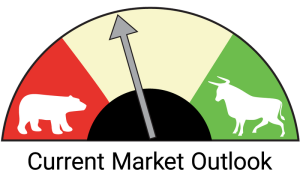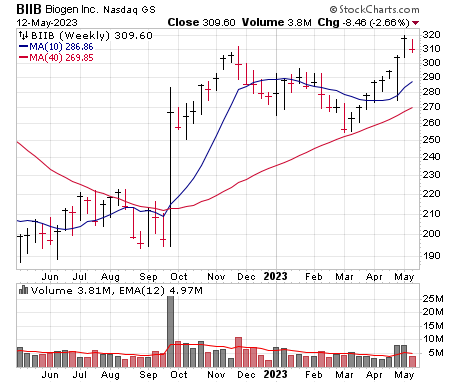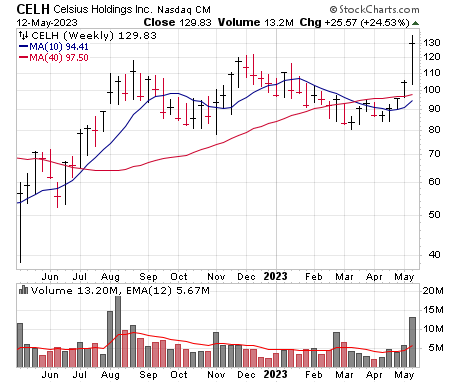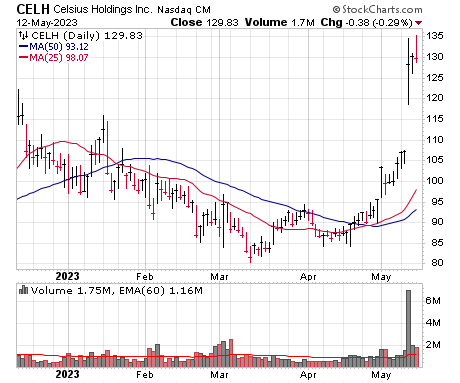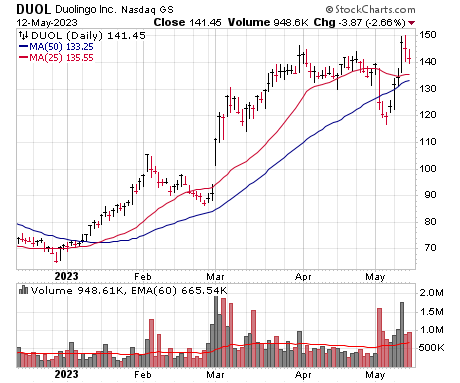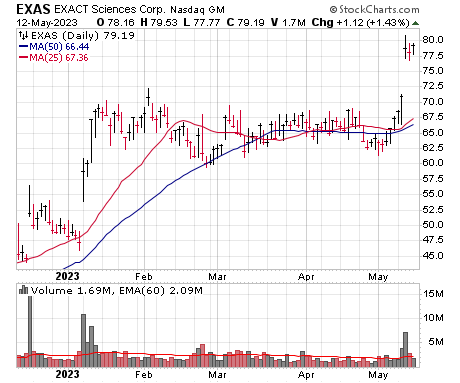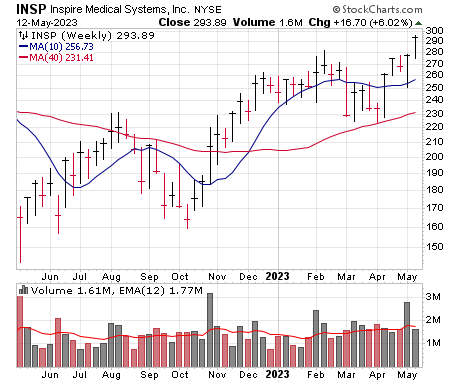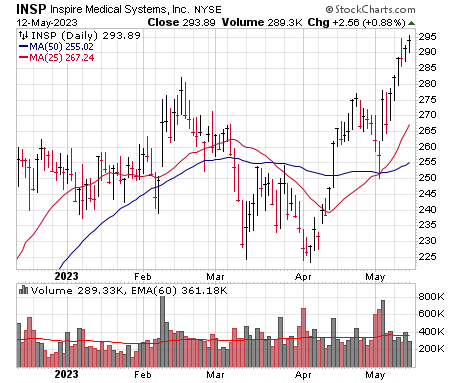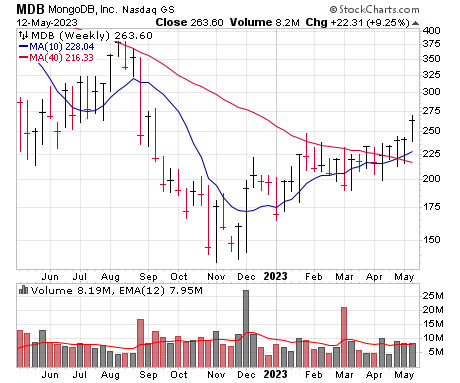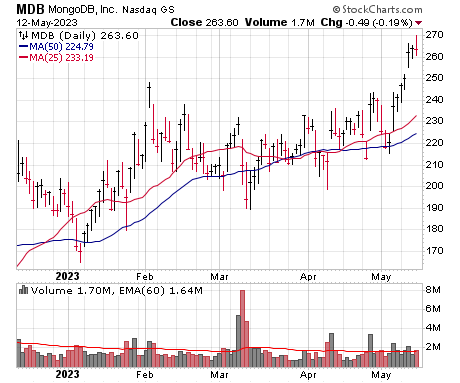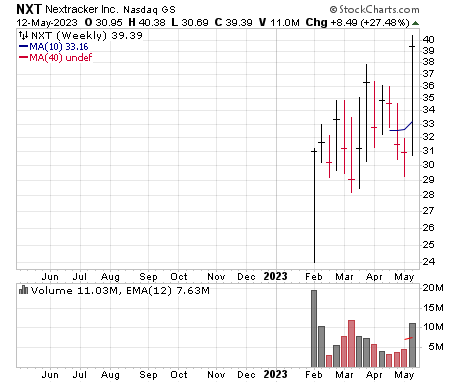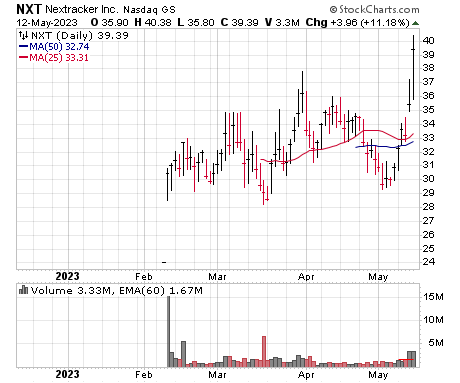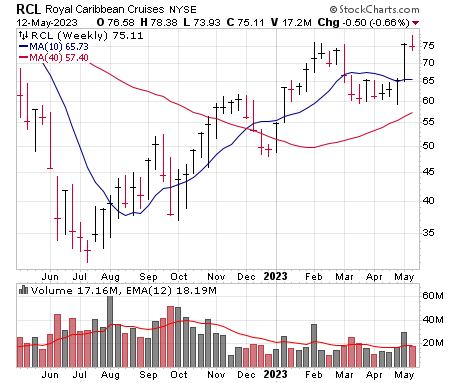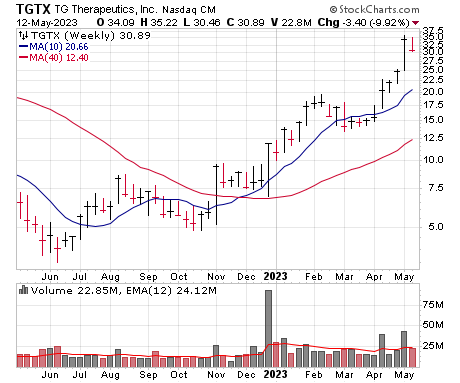Some Leaders Are Trying to Move
Big picture, the factors that have been in place for the past few weeks are still hanging around, with big-cap indexes resilient and the broad market sluggish (bordering on unhealthy), while we’re still seeing a fair number of air pockets among individual stocks. That said, we’re also starting to see more names give it a go on the upside—after a rough start to earnings season, more and more are starting to react well and push through some resistance, with others that did get hit snapping back impressively. (Indeed, today’s list is as growth-y as we’ve seen it in a while.) Is it enough to change our stance? No, not yet, especially given the on-again, off-again environment—we’re leaving our Market Monitor at a level 4—but we’re keeping our antennae up in case the buying pressures spread and more real leaders emerge.
This week’s list has a bunch of strong names with solid numbers and stories, from a variety of industries, too. Our Top Pick is Celsius (CELH), which after toying with new highs a couple of times in recent months, looks to have decisively broken through. Aim to enter on dips.
| Biogen (BIIB) |
| Celsius (CELH) ★ Top Pick ★ |
| Duolingo (DUOL) |
| Exact Sciences (EXAS) |
| Inspire Medical (INSP) |
| MongoDB (MDB) |
| NEXTracker (NXT) |
| Royal Caribbean (RCL) |
| Super Micro Computer (SMCI) |
| TG Therapeutics (TGTX) |
Stock 1
Biogen (BIIB)
Price | Buy Range | Loss Limit |
Why the Strength
Neuroscience firm Biogen has carved out a name for itself thanks to its top-selling portfolio of multiple sclerosis (MS) drugs, led by blockbuster Tecfidera, which has kept profits and margins very healthy. But the company has lately turned its attention to other areas, including Alzheimer’s treatments: Biogen has recently made headlines for lecanemab (sold under the brand name Leqembi), its Alzheimer’s drug that’s made promising strides in clinical trials. In January, the Food and Drug Administration (FDA) granted accelerated approval for the drug, with a decision on whether it will be granted full approval expected by July. If approved, the government said it would cover the drug for Medicare patients, prompting a major institution to upgrade the stock (a reason for the strength). Analysts are projecting that commercial approval for Leqembi could generate more than $7 billion (!) in global sales by 2030, putting it on track to be Biogen’s next blockbuster while paving the way for additional growth opportunities. The firm isn’t putting all its eggs in the Alzheimer’s basket, however; it recently received accelerated FDA approval for the Lou Gehrig’s disease drug, Qalsody—the first approval for a treatment that targets the disease’s genetic cause. Plus, on the MS front, Biogen just won regulatory market protection for Tecfidera in the European Union until 2025, and management said it’s looking at other ways of maximizing the profitability of its MS franchise. Revenue in Q1 was 3% lower from a year ago but beat the consensus by 5%, while EPS of $3.40 was off 6% but topped estimates by 12 cents. And while Wall Street expects a modest sales decline for 2023, the stock will likely trade off the potential upside from Leqembi.
Technical Analysis
BIIB had a couple of false starts in 2020 and 2021, but after months of bottoming action in the 180 to 200 range last year, shares popped last September on hopes for its Alzheimer’s offering, which prompted a run to 312. The stock did pull back from there, but found support above its 40-week line, bounced, and has shown very nice accumulation since earnings in late April. The recent, controlled rest looks normal and buyable.
| Market Cap | $44.6B | EPS $ Annual (Dec) | ||
| Forward P/E | 19 | FY 2021 | 19.13 | |
| Current P/E | 18 | FY 2022 | 17.67 | |
| Annual Revenue | $10.1B | FY 2023e | 15.87 | |
| Profit Margin | 20.0% | FY 2024e | 17.62 | |
| Qtrly Rev | Qtrly Rev Growth | Qtrly EPS | Qtrly EPS Growth | |
| ($B) | (vs. yr-ago-qtr) | ($) | (vs. yr-ago-qtr) | |
| Latest qtr | 2.46 | -3% | 3.40 | -6% |
| One qtr ago | 2.54 | -7% | 4.05 | 19% |
| Two qtrs ago | 2.51 | -10% | 4.77 | 0% |
| Three qtrs ago | 2.59 | -7% | 5.25 | -8% |
Weekly Chart | Daily Chart |
Stock 2
Celsius (CELH) ★ Top Pick ★
Price | Buy Range | Loss Limit |
Why the Strength
Celsius has looked like “the next” Monster Beverage or Red Bull for a while, with a new type of energy drink that’s both healthier (no preservatives, aspartame or high fructose corn syrup) and, according to some studies, actually helps people burn calories by turning on the body’s thermogenesis (body produces heat) response. The firm grew rapidly and took market share for a couple of years as it quickly expanded distribution, not just to convenience stores and supermarkets but also in some key markets like fitness centers (Life Time Fitness) and club stores, too. The big break came last year when Pepsi took a stake in the firm and began the process of shifting Celsius’ distribution over to its platform. For a couple of quarters, that messed with the numbers, with a couple hundred million dollars of extra one-time costs and some inventory juggling to make sure the distribution channels had enough to sell. But now that’s in the past, and as Q1 showed, the power of the new approach shined: Revenues surged 95% from a year ago and 46% from the prior quarter (!), and really the firm is just scratching the surface, as it’s now the third best selling energy drink brand, yet has just 7.5% of the entire market (management sees a runway to 10% in the not too distant future), partially because some areas are barely tapped—international sales were just 5% of the total and foodservice was just 10%, but both have massive potential now that Pepsi’s distribution strength is behind the company. And even with everything going on, margins are improving (gross margin of 44%, up four percentage points from a year ago; EBITDA margin of 18% in Q1), with lower freight and other input costs likely to help the cause going forward, too. The valuation is up there and, of course, there is competition, but Celsius certainly seems to be starting a fresh, accelerating growth wave as the Pepsi deal bears fruit.
Technical Analysis
CELH was hit very hard during the first stages of the bear market, but a clue that something good was happening came when the stock returned to its old highs by last fall. The 120 barrier rejected the stock twice after that, resulting in an up-and down pattern during the next eight months. Frankly, the stock wasn’t looking great recently, but it started to show accumulation a couple of weeks ago and it went vertical after last week’s terrific Q1 report. Volatility here will be very high, but we’re fine grabbing a few shares on modest weakness and using a loose leash.
| Market Cap | $10.1B | EPS $ Annual (Dec) | ||
| Forward P/E | 99 | FY 2021 | 0.05 | |
| Current P/E | N/A | FY 2022 | -0.44 | |
| Annual Revenue | $579M | FY 2023e | 1.32 | |
| Profit Margin | 15.9% | FY 2024e | 2.15 | |
| Qtrly Rev | Qtrly Rev Growth | Qtrly EPS | Qtrly EPS Growth | |
| ($M) | (vs. yr-ago-qtr) | ($) | (vs. yr-ago-qtr) | |
| Latest qtr | 260 | 95% | 0.40 | 344% |
| One qtr ago | 178 | 71% | -0.37 | N/A |
| Two qtrs ago | 188 | 98% | -0.28 | N/A |
| Three qtrs ago | 154 | 137% | 0.12 | 999% |
Weekly Chart | Daily Chart |
Stock 3
Duolingo (DUOL)
Price | Buy Range | Loss Limit |
Why the Strength
Duolingo is a name we’ve written about enthusiastically a couple of times this year, and after a big shakeout and snapback (more on that below), we think it could be setting up its next leg higher. To briefly recap, the firm is a huge deal in language learning (especially English), with a fun, game-like education platform that uses a freemium model, with millions using it for free (with ads) and an increasing number paying up to get more out of it. It’s the top grossing education app on Apple’s and Google’s app stores, and over time, there’s rumblings about expanding beyond language and into other education fields. Growth has been strong for a while and remains so today—in Q1, total monthly active users were a whopping 72.6 million, up 47% from a year ago, with 4.8 million of them paying subscribers (up 63%; the percentage of users that are paying keeps increasing, from 6.8% last year to 8.0% now). And that drove revenues (up 42%) and bookings (up 37%) nicely higher, while free cash flow came in around 70 cents per share, causing the top brass to hike expectations. Prior to the report, shares tanked after a loose education peer (Chegg, symbol CHGG) said AI was eating into its business, but Duolingo went out of its way in last week’s report to detail how AI is actually helping it along, including a machine learning system that makes user experiences more effective and personalized; its English Test (used by tons of universities; made up 8.6% of revenues in Q1) uses AI for content creation, administering and scoring; while AI is being used to more rapidly introduce advanced course content. Big picture, the over one billion (!) exercises users complete on Duolingo each day gives the firm a huge competitive advantage into what works when it comes to language learning. We think Duolingo is going to get a lot bigger over time.
Technical Analysis
DUOL is one of a growing number of “shake-and-snap” charts we’re seeing, where a stock that’s acting well suddenly cracks intermediate-term support on some sort of news or rumor—but then, instead of floundering, it snaps right back, which usually bodes well given that many weak hands were likely shaken out (and eager shorts piled on). That’s what we see with DUOL the past two weeks (volume last week was bigger than the selloff week, a good sign), and while there is always the risk that the stock has another wobble in store, we’re OK with a small position around here.
| Market Cap | $5.80B | EPS $ Annual (Dec) | ||
| Forward P/E | N/A | FY 2021 | -1.63 | |
| Current P/E | N/A | FY 2022 | -1.51 | |
| Annual Revenue | $405M | FY 2023e | -0.55 | |
| Profit Margin | N/A | FY 2024e | -0.04 | |
| Qtrly Rev | Qtrly Rev Growth | Qtrly EPS | Qtrly EPS Growth | |
| ($M) | (vs. yr-ago-qtr) | ($) | (vs. yr-ago-qtr) | |
| Latest qtr | 116 | 42% | -0.06 | N/A |
| One qtr ago | 104 | 42% | -0.35 | N/A |
| Two qtrs ago | 96.1 | 51% | -0.46 | N/A |
| Three qtrs ago | 88.4 | 50% | -0.38 | N/A |
Weekly Chart | Daily Chart |
Stock 4
Exact Sciences (EXAS)
Price | Buy Range | Loss Limit |
Why the Strength
Exact Sciences is building on the strength of its Cologuard colon cancer test to provide a whole suite of non-invasive screens for cancers. Launched less than a decade ago, Cologuard uses stool samples to identify DNA and hemoglobin markers associated with cancers. The company tested more than a million patients in the U.S. in the first quarter, helping revenue to rise 24% to $603 million, with rising EBITDA margins and a narrowing net loss, to 42 cents a share from $1.04 last year. The company estimates Cologuard is used by about 10% of the target U.S. population—mainly people over 50—so there’s still plenty of upside there. Many users are people who had a colonoscopy once and don’t want another, while there are about 60 million people who never had one or have fallen behind on their return screenings; management believes it can quadruple its U.S. Cologuard business alone by capturing more of that group. Partly, that optimism is from finding it easier to convince doctors to use the test thanks to recently switching to the Epic database system used by most of the industry, which allows testing and results to be propagated throughout physicians and hospital systems electronically. Beyond Cologuard, Exact’s expertise in using biomarkers from stool samples has allowed it to develop increasingly utilized screens for breast cancer and prostate cancer (making up about a quarter of revenue). Exact Sciences upped its full year guidance last week on the strength, forecasting about $2.4 billion in sales, up 15% over 2022, and sees free cash flow turning positive later this year (ahead of the original 2024 target). It also sees a good potential market in Canada, where limited capacity for colonoscopies means there’s a seven-year wait.
Technical Analysis
Last autumn EXAS was able to finally break a 21-month downtrend, which saw shares grind down from the all-time high at 160 to a low of 29. The powerful off-the-bottom move ran out of steam in mid-January, but impressively, EXAS held very nicely—it pulled back “only” 18% and mostly marched sideways even as the broad market hit some air pockets. And then, last week, shares broke out nicely after earnings. We’ll set our buy range a bit lower, thinking a dip is likely.
| Market Cap | $14.2B | EPS $ Annual (Dec) | ||
| Forward P/E | N/A | FY 2021 | -3.48 | |
| Current P/E | N/A | FY 2022 | -3.54 | |
| Annual Revenue | $2.20B | FY 2023e | -1.91 | |
| Profit Margin | N/A | FY 2024e | -1.18 | |
| Qtrly Rev | Qtrly Rev Growth | Qtrly EPS | Qtrly EPS Growth | |
| ($M) | (vs. yr-ago-qtr) | ($) | (vs. yr-ago-qtr) | |
| Latest qtr | 603 | 24% | -0.42 | N/A |
| One qtr ago | 553 | 17% | -0.72 | N/A |
| Two qtrs ago | 523 | 15% | -0.84 | N/A |
| Three qtrs ago | 522 | 20% | -0.94 | N/A |
Weekly Chart | Daily Chart |
Stock 5
Inspire Medical (INSP)
Price | Buy Range | Loss Limit |
Why the Strength
We’ve been big fans of Inspire’s story for a long time, though the market had repeatedly kept a lid on the stock—but now there are signs of a character change. The big idea remains the same, and to us, that’s a very good thing: Inspire looks like a potential new gold standard for those that suffer moderate to severe sleep apnea, with a minimally invasive (60 to 90 minutes, outpatient) procedure that implants a a couple of tiny devices that, when turned on by the patient, stimulates a nerve that helps keep the airways open. (The devices are also full-body MRI compatible now and the batteries have an 11-year life.) Of course, CPAP machines are still the most common solution here, but the non-compliance rate with them is gigantic (one- to two-thrids) and Inspire’s solution works amazingly well, with a 70%-ish drop in apnea events and with 90%-plus of patients saying it’s better than CPAP, too. According to Inspire, about two million CPAP machines are prescribed in the U.S. each year, which is a giant market, especially given that Inspire has performed a total of 41,000 surgeries so far; all in all, the firm sees a $10 billion market in the U.S. Expanding the sales and training force isn’t cheap (Inspire is adding 60 to 70 new centers per quarter), which is a reason why the company is still losing money, but it’s not hard to see the writing on the wall—sales growth has 70%-plus for many quarters in a row, and in Q1, that actually accelerated while gross margins are very healthy (mid 80% range). From here on, it’s mostly about management executing its expansion plan in the U.S. (including getting broader approvals; its solution got FDA approval for pediatric Down syndrome patients in Q1) and expanding overseas (countrywide reimbursement in Belgium). We like it.
Technical Analysis
INSP dipped as low as 143 last June, down about 50% from its bull market high, and it hit a higher low near 160 in October before marching all the way back to its 2021 highs. That test of resistance didn’t go well, with shares falling back with the market in March, but INSP held support near the 40-week line, bounced back and, after earnings, has moved to new price and (unlike earlier this year) new relative performance highs, too. Shares are a bit thinly traded and the 300 area could be round-number resistance, but we’re OK nibbling here or preferably on short-term weakness.
| Market Cap | $8.51B | EPS $ Annual (Dec) | ||
| Forward P/E | N/A | FY 2021 | -1.54 | |
| Current P/E | N/A | FY 2022 | -1.60 | |
| Annual Revenue | $466M | FY 2023e | -1.28 | |
| Profit Margin | N/A | FY 2024e | -0.27 | |
| Qtrly Rev | Qtrly Rev Growth | Qtrly EPS | Qtrly EPS Growth | |
| ($M) | (vs. yr-ago-qtr) | ($) | (vs. yr-ago-qtr) | |
| Latest qtr | 128 | 84% | -0.53 | N/A |
| One qtr ago | 138 | 76% | 0.10 | N/A |
| Two qtrs ago | 109 | 77% | -0.60 | N/A |
| Three qtrs ago | 91.4 | 73% | -0.53 | N/A |
Weekly Chart | Daily Chart |
Stock 6
MongoDB (MDB)
Price | Buy Range | Loss Limit |
Why the Strength
Data gathering is a key business strategy today, as advertisers seek to glean insights not just from sales or marketing activities but from newer avenues like social media posts and other online areas—so-called unstructured sources. Traditional databases that store data in a column-type format aren’t equipped to do this, which means a streamlined cross-platform approach is required. This is where MongoDB comes into play; the company provides general purpose, document database systems that have become the industry standard for software developers and others; effectively, after decades of no innovation, Mongo is one of the leaders in these new-age databases that are being gobbled up by businesses. Growth has been solid, though slowing due to the overall economic environment—but the stock is strong as some on Wall Street think any slowdown should be temporary. In April, one analyst hiked his rating after a survey revealed 73% of respondents are actively pursuing cloud optimization initiatives (which involve correctly assigning resources to a workload or application). The survey also suggested that migration to the cloud will accelerate into 2024, with related artificial intelligence (AI) development expected to increase. In fiscal Q1, revenues were still growing quickly, up 36% from a year ago and per-share earnings of 57 cents boomed from 12 cents a year ago. MongoDB’s multicloud database service, Atlas, saw revenue surge 50% and make up nearly two-thirds of total sales. Customer growth also continued apace with nearly 41,000 clients (up 45%), and retention rates were described as “very strong.” The next quarterly report (due June 1) will be key, especially if there’s any hint that demand is coming in stronger than feared.
Technical Analysis
From nearly 600 in November 2021 to 140-ish last fall, MDB was taken apart during the worst of the bear phase. A very bullish reaction to earnings in December (the stock’s biggest weekly volume ever) changed the tune, with shares pushing up to around 250 in February. And, like many names, it spent the next three months etching a tighter, more proper base—with a nice pop to eight-month highs last week. Given the volatility and the market, we suggest aiming for pullbacks if you want in.
| Market Cap | $18.6B | EPS $ Annual (Jan) | ||
| Forward P/E | 240 | FY 2022 | -0.02 | |
| Current P/E | 343 | FY 2023 | 0.81 | |
| Annual Revenue | $1.29B | FY 2024e | 1.11 | |
| Profit Margin | 12.8% | FY 2025e | 1.68 | |
| Qtrly Rev | Qtrly Rev Growth | Qtrly EPS | Qtrly EPS Growth | |
| ($M) | (vs. yr-ago-qtr) | ($) | (vs. yr-ago-qtr) | |
| Latest qtr | 361 | 36% | 0.57 | 375% |
| One qtr ago | 334 | 47% | 0.23 | 667% |
| Two qtrs ago | 304 | 53% | -0.23 | N/A |
| Three qtrs ago | 286 | 57% | 0.20 | N/A |
Weekly Chart | Daily Chart |
Stock 7
NEXTracker (NXT)
Price | Buy Range | Loss Limit |
Why the Strength
With solar panels playing an increasingly larger role in power generation, the complex instruments that automatically move those panels to capture the maximum amount of sunlight are in high demand. NEXTracker is the leading provider of intelligent, integrated solar tracker and software solutions used in utility-scale and ground-mounted distributed generation solar projects around the world. There’s no question this is a growth industry, especially in the wake of the 2022 green energy bill: A recent industry survey found that solar was the single biggest source of energy generating capacity added to U.S. grids in 2021, with utility-scale solar comprising over 70% of the new additions, positioning NEXTracker to benefit. The aforementioned green energy bill provides generous tax credits for both business and residential solar projects; the full impact of those credits should grow into the second half of next year, when annual U.S. solar installations are predicted to average 35 gigawatts—a 170% increase from the current installation average. Last week, the company reported its first quarterly earnings result since going public, with estimate-beating Q1 revenue of $518 million and full-fiscal-year sales of nearly $2 billion (up 30% from a year ago), while fiscal Q4 earnings lifted to 38 cents per share, nearly triple that of a year ago and well above estimates. NEXTracker’s backlog grew to $2.6 billion (up 90%), with key wins reported in North and South America, Australia and Europe (reasons for the stock’s strength). Looking ahead, sales are likely to crank ahead in the 15% to 20% range while earnings expand much faster during the next couple of years. It could be a fresh leader in the solar group.
Technical Analysis
NXT just came public on February 9, so there isn’t much trading history to go on. That said, we like that the stock resisted the typical letdown that often follows initial offerings, especially given the market environment. NXT spent the first three months of its life in a range between 28 and 36, with last week’s earnings causing two straight days of heavy volume buying to new highs. To be fair, shares have just popped from 30 to 40, so aim for dips and keep positions on the small side.
| Market Cap | $1.77B | EPS $ Annual (Mar) | ||
| Forward P/E | 27 | FY 2022 | 0.49 | |
| Current P/E | 34 | FY 2023 | 1.03 | |
| Annual Revenue | $1.90B | FY 2024e | 1.40 | |
| Profit Margin | N/A | FY 2025e | 1.86 | |
| Qtrly Rev | Qtrly Rev Growth | Qtrly EPS | Qtrly EPS Growth | |
| ($M) | (vs. yr-ago-qtr) | ($) | (vs. yr-ago-qtr) | |
| Latest qtr | 518 | 18% | 0.38 | 171% |
| One qtr ago | 513 | 52% | 0.29 | 222% |
| Two qtrs ago | 467 | 38% | 0.18 | 38% |
| Three qtrs ago | 403 | 18% | 0.18 | 38% |
Weekly Chart | Daily Chart |
Stock 8
Royal Caribbean (RCL)
Price | Buy Range | Loss Limit |
Why the Strength
With Covid restrictions no longer a headwind for the tourism industry, experts believe 2023 will be the year of so-called “revenge travel,” in which the pent-up demand from recent years is fully unleashed. Royal Caribbean is the world’s third-largest cruise line by annual revenue, and despite signs that consumers are pulling back on discretionary spending, the company says people are still willing to pay up for cruises. Indeed, a survey conducted by a major Wall Street bank found that bookings for Royal Caribbean and its key competitors are higher than the pre-pandemic levels of 2019, concluding that Royal Caribbean would likely outperform its peers on the top and bottom lines this year. Earlier this month, the firm’s Q1 results featured a head-turning 173% increase in revenue to nearly $2.9 billion (the reason for the stock’s strength), and while earnings were in the red, they still still exceeded estimates by a huge 46 cents. The rosy results significantly exceeded the company’s guidance, thanks to strong close-in bookings at higher prices, continued strength in on-ship spending and favorable timing of operating costs during “Wave Season” (the period between January and March when cruise lines typically offer discounted rates). Probably more important was that the top brass said it was “pleasantly surprised” how quickly cruise demand accelerated above historical trends and at higher rates—a development it sees continuing as consumer spending shifts further toward experiences. As a result of its record-breaking Wave Season, Royal Caribbean guided for adjusted EBITDA this year to “significantly exceed” the prior record achieved in 2019, with earnings expected to explode well above $4 this year and continue higher into 2024.
Technical Analysis
RCL fell from around 100 in 2021 to a low of 31 last year before rallying choppily back into the 75 area earlier this year. Shares did fall quickly in March when the banking crisis hit, but it tightened up near 60 and, now, RCL has powered back to its recent highs after earnings. We’ll put our buy range down a smidge from here as the stock still has some resistance to chew through.
| Market Cap | $19.0B | EPS $ Annual (Dec) | ||
| Forward P/E | 16 | FY 2021 | -19.19 | |
| Current P/E | N/A | FY 2022 | -7.50 | |
| Annual Revenue | $10.7B | FY 2023e | 4.70 | |
| Profit Margin | N/A | FY 2024e | 6.94 | |
| Qtrly Rev | Qtrly Rev Growth | Qtrly EPS | Qtrly EPS Growth | |
| ($B) | (vs. yr-ago-qtr) | ($) | (vs. yr-ago-qtr) | |
| Latest qtr | 2.89 | 172% | -0.23 | N/A |
| One qtr ago | 2.60 | 165% | -1.12 | N/A |
| Two qtrs ago | 2.99 | 555% | 0.26 | N/A |
| Three qtrs ago | 2.18 | 999% | -2.08 | N/A |
Weekly Chart | Daily Chart |
Stock 9
Super Micro Computer (SMCI)
Price | Buy Range | Loss Limit |
Why the Strength
Demand for greater computing power from the swift adoption of AI means Super Micro Computer sees sales of its unique servers accelerating. Management tightened its revenue guidance for fiscal 2023, ending June 30, during its earnings announcement two weeks ago, saying sales will rise 29% or so, to $6.8 billion, compared to earlier expectations of a 20% gain year over year. The improved outlook more than offset weakness in its recently reported Q3, in which a shortage of supplies led the business to underperform its initial expectations—indeed, revenue actually dipped 5% following some recent huge gains. Even so, earnings per share rose 5% in the period, to $1.63, and the firm also inked agreements with two top 20 global businesses that should start to add to the top line. Super Micro Computer’s main product is Plug-n-Play Rack-Scale, an easy-to-install server system. Its whole GPU line has been refreshed in recent months, with server systems called Sapphire Rapids, Genoa and H100 powered with NVIDIA and AMD chips. The company says they foresee an expanding customer base that should result in faster sales growth than seen in previous product cycles. In addition to AI, the Internet of Things, 5G networks, cloud and ever-increasing corporate datacenters will fuel demand, leading management to say fiscal 2024 (starting in July) should generate sales growth of at least 20%. Long term, the company’s focus on energy-efficient products is another differentiator. Super Micro’s Green Computing offerings use energy-efficient chips, free-air cooling (using cooler exterior air to help regulate temperatures), and pooled computing resources results in power usage up to a third less than a traditional data center. Earnings are expected to remain elevated, yet estimates still look conservative.
Technical Analysis
SMCI has been in a steep but very volatile uptrend since late last year, with huge rallies often followed by sharp, multi-week declines or briefer shakeouts. That pattern is still playing out, with SMCI rallying to nearly 120 in March and April and then sinking 22% in just five days! However, the quarterly report brought the buyers back in, with shares easily moving to new highs. The stock isn’t in the first inning of its advance, which is a risk, but dips of a few points should mark a decent entry.
| Market Cap | $7.03B | EPS $ Annual (Jun) | ||
| Forward P/E | 12 | FY 2021 | 2.48 | |
| Current P/E | 12 | FY 2022 | 5.65 | |
| Annual Revenue | $6.57B | FY 2023e | 10.73 | |
| Profit Margin | 7.3% | FY 2024e | 10.93 | |
| Qtrly Rev | Qtrly Rev Growth | Qtrly EPS | Qtrly EPS Growth | |
| ($B) | (vs. yr-ago-qtr) | ($) | (vs. yr-ago-qtr) | |
| Latest qtr | 1.28 | -5% | 1.63 | 5% |
| One qtr ago | 1.80 | 54% | 3.26 | 270% |
| Two qtrs ago | 1.85 | 79% | 3.42 | 490% |
| Three qtrs ago | 1.64 | 53% | 2.62 | 223% |
Weekly Chart | Daily Chart |
Stock 10
TG Therapeutics (TGTX)
Price | Buy Range | Loss Limit |
Why the Strength
TG Therapeutics is known for its targeted and immune therapies for B-cell cancers, but in recent years the firm has shifted more of its focus toward discovering treatments for autoimmune disorders like relapsing multiple sclerosis (RMS). Its recently approved RMS therapy, the anti-CD20 monoclonal antibody Briumvi (which has an annualized maintenance price of $59,000), was also approved to treat clinically isolated syndrome, relapsing-remitting disease and active secondary progressive disease in adults. Recent data highlighted strong sales for Briumvi, which recorded more than 400 prescriptions across 125 treatment centers nationwide in Q1, and it has payor coverage policies in place for over 50% of covered lives across the U.S. The sanguine news prompted a major financial institution to raise its target for TG (a reason for the strength). The sales growth was affirmed by the release of the company’s Q1 report, which showed Briumvi sales of almost $8 million, with the per-share loss of 28 cents improving substantially from a year ago while surprising the consensus by 20%. Obviously, the numbers right now are small but that will change—analysts see the top line hitting $83 million this year and $250 million next, with plenty of upside beyond that. The company is now seeking a pathway for Briumvi sales in Europe, with the drug receiving a positive opinion from the European Medicines Agency (EMA) recommending Briumvi’s approval for treating adult RMS patients (a final opinion is expected by early June; if approved, TG plans a commercial launch on the continent later this year). The company ended Q1 with a “comfortable” $160 million in cash, which it said would be sufficient funding into mid-2024 (or longer if revenues continue to exceed its expectations). It’s a solid developmental-to-commercial biotech story.
Technical Analysis
TGTX finally bottomed out last June at 4 shortly after the firm voluntarily withdrew sales of its lymphoma therapy, Ukoniq. The news was already factored into the price, however, and shares started to repair the damage, with a powerful move last November and a run to nearly 20 in February. TGTX did pull in with the market in March, but since then it’s exploded higher as good fundamental tidings (and some buyout rumors) hit the wires. It’s a hot but strong potato—dips of a couple of points would be tempting, but use a loose leash.
| Market Cap | $4.70B | EPS $ Annual (Dec) | ||
| Forward P/E | N/A | FY 2021 | -2.63 | |
| Current P/E | N/A | FY 2022 | -1.46 | |
| Annual Revenue | N/M | FY 2023e | -1.04 | |
| Profit Margin | N/A | FY 2024e | -0.08 | |
| Qtrly Rev | Qtrly Rev Growth | Qtrly EPS | Qtrly EPS Growth | |
| ($M) | (vs. yr-ago-qtr) | ($) | (vs. yr-ago-qtr) | |
| Latest qtr | 7.8 | N/M | -0.28 | N/M |
| One qtr ago | 0.1 | N/M | -0.39 | N/M |
| Two qtrs ago | 0.1 | N/M | -0.26 | N/M |
| Three qtrs ago | 0.6 | N/M | -0.30 | N/M |
Weekly Chart | Daily Chart |
Previously Recommended Stocks
| Date | Stock | Symbol | Top Pick | Original Buy Range | 5/15/23 |
| HOLD | |||||
| 4/10/23 | 50.5-52.5 | 54 | |||
| 9/12/22 | ★ | 48.5-51.5 | 59 | ||
| 5/1/23 | 54.5-56 | 57 | |||
| 4/3/23 | 86-88 | 118 | |||
| 4/17/23 | 63-64 | 67 | |||
| 3/13/23 | 17.3-18.0 | 23 | |||
| 4/24/23 | ★ | 105-108.5 | 110 | ||
| 3/6/23 | ★ | 115-121 | 143 | ||
| 5/1/23 | 34.5-35.5 | 38 | |||
| 5/1/23 | 52-54 | 57 | |||
| 3/20/23 | 378-388 | 472 | |||
| 4/17/23 | 102-104 | 110 | |||
| 4/24/23 | 262-270 | 295 | |||
| 4/24/23 | 58.5-60.5 | 65 | |||
| 4/24/23 | 285-295 | 308 | |||
| 3/27/23 | 38-39.5 | 46 | |||
| 5/1/23 | ★ | 62.5-65 | 60 | ||
| 5/8/23 | Legend Biotech | LEGN | 64-67 | 73 | |
| 3/20/23 | 105-107 | 113 | |||
| 5/8/23 | Martin Marietta | MLM | 388-398 | 405 | |
| 2/27/23 | 225-230 | 289 | |||
| 5/1/23 | 63-66 | 65 | |||
| 3/27/23 | 28.5-31 | 33 | |||
| 1/9/23 | ★ | 218-226 | 316 | ||
| 5/1/23 | 51.5-53.5 | 55 | |||
| 4/17/23 | 47-48.5 | 51 | |||
| 5/8/23 | Shake Shack | SHAK | ★ | 63-65 | 70 |
| 11/21/22 | 44-46 | 64 | |||
| 5/8/23 | SiteOne Landscape | SITE | 146-151 | 151 | |
| 3/27/23 | 124-128 | 144 | |||
| 5/8/23 | Uber | UBER | 37-39 | 38 | |
| 4/17/23 | 223-229 | 232 | |||
| 5/1/23 | 330-340 | 336 | |||
| 3/20/23 | 44-45 | 51 | |||
| 8/22/22 | 115-120 | 207 | |||
| 5/8/23 | XPO Logistics | XPO | 44.5-46.5 | 47 | |
| WAIT | |||||
| 5/8/23 | 40.5-42 | 43 | |||
| 5/8/23 | Zillow | Z | 49.5-50.5 | 46 | |
| SELL RECOMMENDATIONS | |||||
| 3/6/23 | ★ | 215-222 | 204 | ||
| 4/17/23 | 149-151.5 | 152 | |||
| 11/7/22 | ★ | 145-150 | 199 | ||
| 4/17/23 | 233-240 | 232 | |||
| 12/5/22 | Wynn Resorts | WYNN | 81-84 | 105 | |
| DROPPED | |||||
| 5/1/23 | 31-32 | 28 | |||
The next Cabot Top Ten Trader issue will be published on May 22, 2023.

